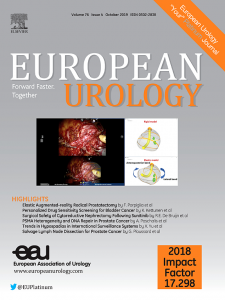前列腺和肾脏手术中单端口和多端口机器人辅助入路的比较:系统回顾和荟萃分析
IF 25.2
1区 医学
Q1 UROLOGY & NEPHROLOGY
引用次数: 0
摘要
背景与目的本系统综述结合meta分析的目的是评估单端口(SP)机器人手术在前列腺和肾脏疾病手术治疗中的围手术期、功能和肿瘤预后。方法采用MEDLINE和Scopus数据库对截至2024年12月已发表的文献进行系统评价。在机器人辅助手术中,特别是根治性前列腺切除术(RARP)、单纯性前列腺切除术(RASP)、部分肾切除术(RAPN)、根治性肾切除术(RARN)和肾盂成形术(RAP; PROSPERO登记号:CRD42025616519),比较SP与多通道(MP)入路的研究被纳入。评估所有手术的围手术期结果。对RARP患者的功能和肿瘤结果进行了专门分析,同时对RAPN患者的热缺血时间(WIT)、脱钳率和手术切缘阳性率进行了评估。主要发现和局限性共有26项、3项、9项、1项和2项研究分别评估了RARP、RASP、RAPN、RARN和RAP。与MP-RARP相比,SP-RARP与更低的估计失血量(标准化平均差[SMD] = 0.51; 95%可信区间[CI]: 0.16-0.87)、更短的住院时间(SMD = 1.12; 95% CI: 0.63-1.62)和减少术后疼痛(SMD = 0.12; 95% CI: 0.04-0.35)相关。SP-和MP- rasp之间的唯一区别是MP组使用更高的吗啡毫克当量(SMD = 0.59; 95% CI: 0.01-1.16)。在接受RAPN的患者中,SP与WIT的相关性显著高于MP (SMD = -0.32; 95% CI: -0.58至-0.06)。然而,住院时间(SMD = 0.31, 95% CI: 0.03-0.59)和术后第1天疼痛评分(SMD = 0.22, 95% CI: 0.01-0.43)均明显支持SP-RAPN。局限性在于缺乏随机试验,以及手术技术和结局定义的跨研究异质性。结论和临床意义与MP方法相比,SP机器人手术在减少术后疼痛和住院时间方面具有优势。在接受RARP的患者中,两种方法的功能和肿瘤结果是相似的。在接受RAPN的患者中,SP入路与更长的WIT相关。本文章由计算机程序翻译,如有差异,请以英文原文为准。
Comparison of Single- and Multiport Robot-assisted Approaches in Prostate and Renal Surgery: A Systematic Review and Meta-analysis
Background and objective
The aim of this systematic review with meta-analysis was to assess the perioperative, functional, and oncological outcomes of single-port (SP) robotic procedures in the surgical management of prostate and renal diseases.Methods
A systematic review was conducted using the MEDLINE and Scopus databases, covering literature published up to December 2024. Studies were included if these compared SP versus multiport (MP) approaches in robot-assisted procedures, specifically radical prostatectomy (RARP), simple prostatectomy (RASP), partial nephrectomy (RAPN), radical nephrectomy (RARN), and pyeloplasty (RAP; PROSPERO registration number: CRD42025616519). Perioperative outcomes were assessed across all procedures. Functional and oncological outcomes were analysed specifically in patients undergoing RARP, while warm ischaemia time (WIT), off-clamp rates, and positive surgical margin rates were evaluated in those undergoing RAPN.Key findings and limitations
A total of 26, three, nine, one, and two studies evaluated RARP, RASP, RAPN, RARN, and RAP, respectively. Compared with MP-RARP, SP-RARP was associated with lower estimated blood loss (standardised mean difference [SMD] = 0.51; 95% confidence interval [CI]: 0.16–0.87), shorter length of stay (SMD = 1.12; 95% CI: 0.63–1.62), and reduced postoperative pain (SMD = 0.12; 95% CI: 0.04–0.35). The only difference between SP- and MP-RASP was represented by the use of a higher morphine milligram equivalent in the MP group (SMD = 0.59; 95% CI: 0.01–1.16). In patients undergoing RAPN, SP was associated with a significantly higher WIT than MP (SMD = –0.32; 95% CI: –0.58 to –0.06). However, the length of hospital stay (SMD = 0.31; 95% CI: 0.03–0.59) and pain score on postoperative day 1 (SMD = 0.22; 95% CI: 0.01–0.43) were significantly in favour of SP-RAPN. Limitations were the lack of randomised trials, and the across-study heterogeneity in surgical techniques and outcome definitions.Conclusions and clinical implications
Compared with the MP approach, SP robotic surgery offers advantages in terms of reduced postoperative pain and hospital stay. In patients undergoing RARP, functional and oncological outcomes were comparable between the two approaches. In patients undergoing RAPN, the SP approach was associated with a longer WIT.求助全文
通过发布文献求助,成功后即可免费获取论文全文。
去求助
来源期刊

European urology
医学-泌尿学与肾脏学
CiteScore
43.00
自引率
2.60%
发文量
1753
审稿时长
23 days
期刊介绍:
European Urology is a peer-reviewed journal that publishes original articles and reviews on a broad spectrum of urological issues. Covering topics such as oncology, impotence, infertility, pediatrics, lithiasis and endourology, the journal also highlights recent advances in techniques, instrumentation, surgery, and pediatric urology. This comprehensive approach provides readers with an in-depth guide to international developments in urology.
 求助内容:
求助内容: 应助结果提醒方式:
应助结果提醒方式:


